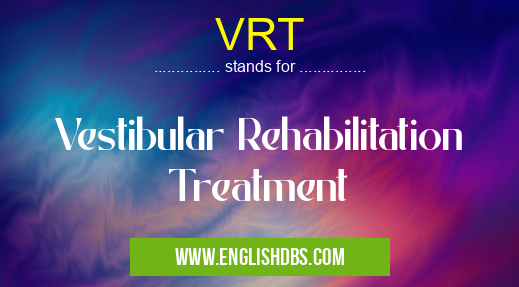What does VRT mean in HOSPITALS
Vestibular Rehabilitation Treatment (VRT) is an evidence-based therapy to provide relief from the symptoms of balance and dizziness disorders. It is a holistic approach that looks to create a customized plan to reduce pain, decrease fall risk, and improve overall bodily mobility for those affected. VRT primarily uses exercises tailored specifically for the individual patient’s needs, as well as lifestyle modifications and counseling to help support the treatment process.

VRT meaning in Hospitals in Medical
VRT mostly used in an acronym Hospitals in Category Medical that means Vestibular Rehabilitation Treatment
Shorthand: VRT,
Full Form: Vestibular Rehabilitation Treatment
For more information of "Vestibular Rehabilitation Treatment", see the section below.
Subject Matter
VRT treats a range of problems stemming from vestibular deficits, some of which include benign paroxysmal positional vertigo (BPPV), concussion/mild traumatic brain injury (MTBI), cervicogenic dizziness, stroke, Meniere’s disease, peripheral vestibulopathy, and more. By targeting the vestibular system or inner ear with specific maneuvers and exercises, VRT can help re-train the system to adapt to its new capabilities in addition to reducing any associated anxiety or fear. Since it also takes into account each person’s individual lifestyles and daily activities, this allows for a careful monitoring of how their daily movement patterns are affecting them in order to create an appropriate management plan with maximum improvement outcomes.
Process & Benefits
The initial step in any VRT program is an assessment by a trained healthcare professional who will then use various tests in order to define the central cause of the issue. From there, they will create a customized treatment program consisting of repositioning exercises - such as head rotations or other movements - aimed at adjusting inner ear structures back into proper alignment; adaptation exercises intended to increase tolerance levels; gaze stabilization activities developed to hone one’s ability focus on moving objects; strength training designed to improve balance control; aerobic conditioning geared toward increasing energy levels; lifestyle modifications; relaxation techniques; and much more. The ultimate goal here is not only symptom relief but also improved quality of life through increased independence following VRT treatments.
Essential Questions and Answers on Vestibular Rehabilitation Treatment in "MEDICAL»HOSP"
What is Vestibular Rehabilitation Treatment?
Vestibular Rehabilitation Treatment (VRT) is an evidence-based form of physical therapy designed to assess, diagnose, and treat inner ear conditions which can cause dizziness, vertigo, imbalance, and visual disturbances. VRT utilizes exercises to retrain the vestibular system to improve balance and coordination.
What are the benefits of VRT?
By undergoing VRT, many patients report improved balance and coordination, reducing the feeling of dizziness or vertigo as well as fewer episodes of falls due to instability. Additionally, VRT may help restore confidence in an individual’s ability to perform daily activities.
Who should consider VRT?
Individuals with diagnosed or suspected vestibular disorders can benefit from VRT. These include people suffering from benign paroxysmal positional vertigo (BPPV), labyrinthitis/vestibular neuritis, Meniere's disease, acoustic neuromas, stroke with associated vestibular deficits and concussion/mild traumatic brain injury (MTBI).
Does insurance cover physical therapy for vestibular rehabilitation treatment?
Coverage varies by insurance policy so it is important to check with your provider before initiating treatment. It may be necessary to obtain a referral from your doctor depending on your plan.
How long does vestibular rehabilitation therapy take?
The duration of treatment depends on multiple variables such as the severity of symptoms at presentation as well as response to interventions during treatment sessions. Generally speaking however; a typical course of treatment ranges between 6-12 visits over several weeks or months.
What types of exercises are used in VRT?
Specific exercises vary depending on each individual patient’s diagnosis and needs but will usually involve head postures while performing various activities such as sitting up/lying down; walking on straight lines then curved patterns; efficient gaze control while standing; dynamic balance activities etc..
Is there any pain associated with the exercises involved in this type of therapy?
No! There is no pain associated with the exercises utilized during VRT. In fact, most exercises are designed specifically to be comfortable and tolerable so that they can be completed without significant difficulty or fatigue.
Final Words:
Based on research studies conducted by medical professionals over recent decades has shown that Vestibular Rehabilitation Therapy (VRT) can be extremely effective in both reducing dizziness symptoms while also improving overall functional performance by targeting the special needs of each individual patient. With careful guidance from any qualified experienced therapist/ practitioner who understands these treatments thoroughly, it is possible for those suffering from similar issues seek whole body healing while also avoiding disability due to their condition.
VRT also stands for: |
|
| All stands for VRT |
